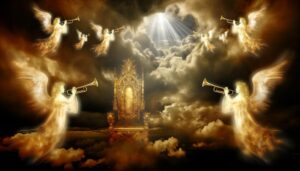Christmas Star Meaning in the Bible: Divine Guidance
The Christmas Star, referenced in the Gospel of Matthew, bears deep theological resonance, symbolizing the divine announcement of Jesus Christ’s birth. This celestial event is seen as a fulfillment of Old Scriptures prophecies, such as those in Numbers 24:17 and Isaiah 60:3, which anticipated a significant divine intervention.
The Star guided the Magi in their spiritual pilgrimage, indicating Jesus’ messianic identity and the broader theme of divine revelation. Its role in the nativity story integrates historical, symbolic, and astronomical facets, inviting deeper exploration into its multiple layers of significance.

Biblical Meaning of the Christmas Star: Divine Guidance, Prophecy, and Hope
| Interpretation | Meaning | Explanation |
|---|---|---|
| Guidance to Christ | Symbol of divine guidance and revelation. | The Star of Bethlehem led the wise men (Magi) to Jesus’ birthplace, symbolizing God’s direction toward His Son (Matthew 2:1-2). |
| Fulfillment of Prophecy | Represents the fulfillment of Messianic prophecies. | The star was a sign that the prophecies about the Messiah were coming true, as foretold in Numbers 24:17: “A star will come out of Jacob.” |
| Light of the World | Symbol of Jesus as the Light bringing hope and salvation to the world. | The star reflects Jesus’ role as the “light of the world” (John 8:12), guiding people to truth and eternal life. |
| Divine Kingship | Represents the acknowledgment of Jesus’ divine kingship and authority. | The star led the Magi, who brought gifts fit for a king, recognizing Jesus’ role as King of Kings (Matthew 2:11). |
| Hope and New Beginnings | Symbolizes hope, new beginnings, and God’s promises. | The star marked the beginning of a new era of salvation through Christ, signifying hope for humanity. |
Biblical Accounts of the Star
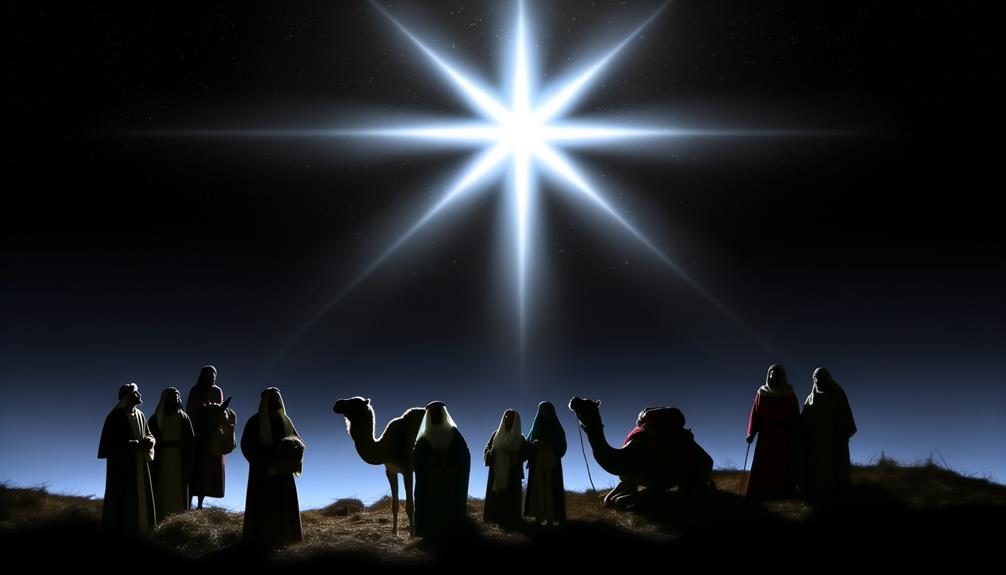
Referencing both the Gospel of Matthew and various apocryphal texts, the biblical accounts of the Star of Bethlehem present a multifaceted narrative that has intrigued theologians and scholars for centuries.
In Matthew 2:1-12, the star is described as guiding the Magi from the East to Jerusalem and ultimately to the birthplace of Jesus in Bethlehem. This celestial phenomenon is often interpreted as a divine sign, fulfilling Old Covenant prophecies of the Messiah’s coming.
Apocryphal texts, such as the Protoevangelium of James, offer supplementary details, enhancing the star’s symbolic significance.
The convergence of scriptural and extra-biblical sources underscores the star’s pivotal role in the nativity story, while fueling ongoing debates about its historical and astronomical plausibility.
The Magi and Their Journey
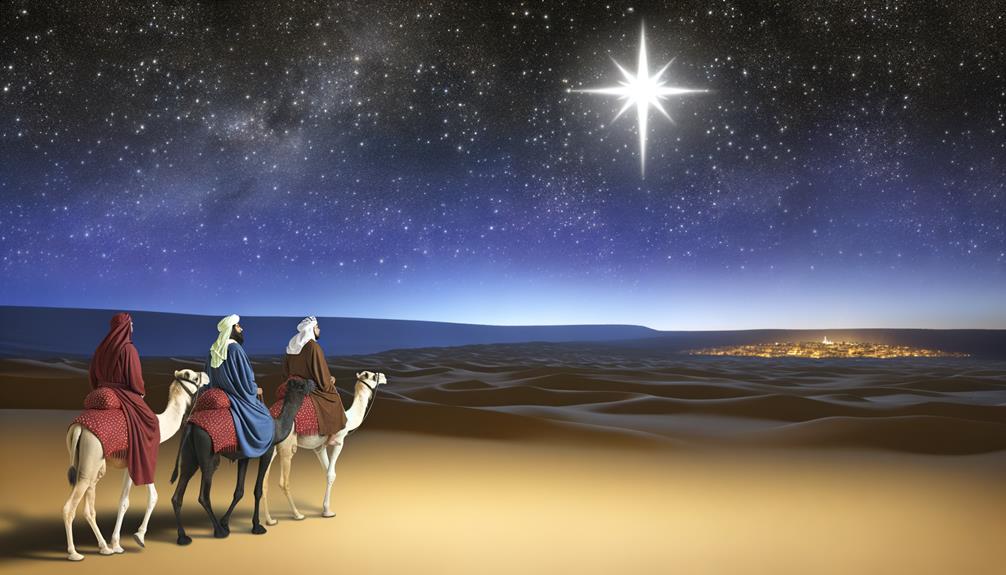
The journey of the Magi, guided by the celestial phenomenon known as the Christmas Star, represents a significant narrative within the Christian tradition.
Their expedition highlights the interpretive power of astrological symbols and the subsequent homage they paid to the newborn Jesus through their offerings of gold, frankincense, and myrrh.
This act of following the star and presenting gifts underscores the theological and cultural implications of divine revelation and human response.
Following the Star
Guided by the celestial phenomenon known as the Star of Bethlehem, the Magi commenced on a momentous journey that has been richly documented in both historical and theological contexts.
This star, often interpreted as a miraculous sign from God, catalyzed their expedition from the East towards Jerusalem, eventually leading them to Bethlehem.
The Gospel of Matthew details their quest, emphasizing their role as seekers of divine truth.
The journey of the Magi symbolizes a spiritual pilgrimage, reflecting a broader human quest for meaning and enlightenment.
Their unwavering commitment to follow the star, despite uncertainties, underscores the profound faith and determination inherent in their voyage, offering valuable insights into the themes of guidance and revelation in biblical narratives.
Gifts for Jesus
Throughout their journey, the Magi carried with them gifts of profound symbolic significance for the infant Jesus. The three gifts—gold, frankincense, and myrrh—each hold deep theological and historical connotations.
Gold, a symbol of kingship and divinity, acknowledges Jesus’ royal status.
Frankincense, often used in religious rituals, underscores His priestly role and divine nature.
Myrrh, a resin used in embalming, foreshadows His future suffering and death.
These offerings not only highlight the recognition of Jesus’ multifaceted identity by the Magi but also align with Old scriptures prophecies and cultural understandings of the time.
The gifts, consequently, are not mere tokens of respect but are laden with rich, prophetic meaning that underscores the narrative of Christ’s life and mission.
Prophecies of the Star
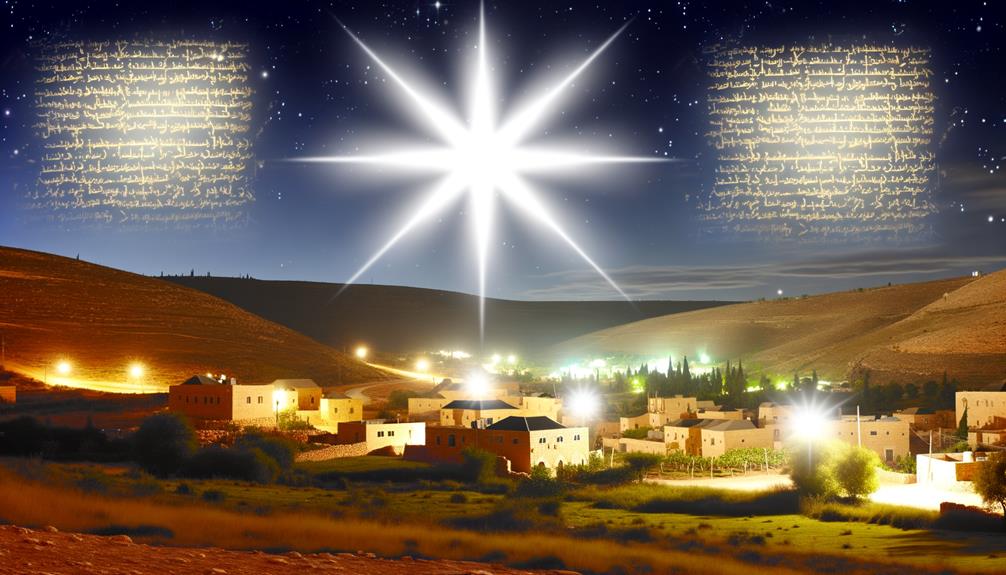
In ancient texts, numerous prophecies foretold the appearance of a star heralding a momentous event, often interpreted as the birth of a significant figure.
The Book of Numbers (24:17) references a star coming forth from Jacob, symbolizing a future leader. Similarly, Isaiah 60:3 speaks of nations coming to the light and kings to the brightness of the rising.
These prophecies were understood within their historical and cultural contexts as portents of divine intervention.
Early Christian interpretations linked these references directly to the Star of Bethlehem, seen as signaling the advent of Jesus Christ. The Star of Bethlehem has been a symbol of hope and divine guidance for millions of Christians, and its appearance in the sky was seen as a miraculous sign of the coming of Christ in Bible. Throughout history, scholars and theologians have debated the nature of the star and its significance in the story of Jesus’ birth, with some even suggesting that it may have been a supernatural event or a purely symbolic element in the Gospel narratives. Regardless of its exact nature, the Star of Bethlehem remains a powerful and enduring symbol of the Christmas story for Christians around the world.
Such prophecies underscored a broader eschatological anticipation, intertwining celestial phenomena with theological fulfillment in Judeo-Christian thought.
The Star as a Sign
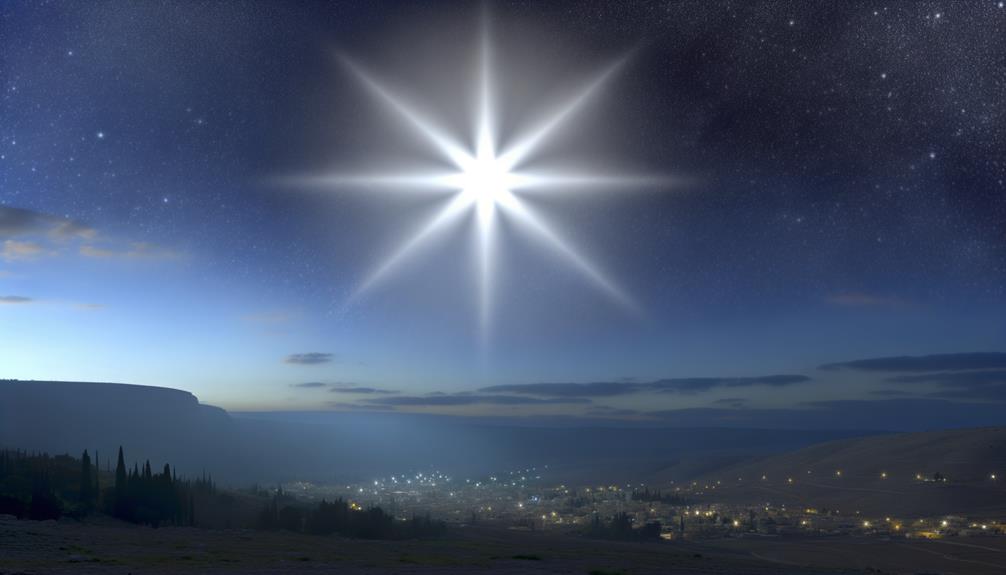
The Star of Bethlehem has long been analyzed as a celestial sign, suggesting divine orchestration and conveying profound theological implications for early Christian communities. This star is perceived not merely as an astronomical phenomenon but as a divine signal heralding the birth of Jesus Christ.
In the context of biblical narratives, such a sign aligns with the notion of divine intervention and revelation, indicating God’s active role in human history. The star’s guidance of the Magi to the infant Jesus symbolizes the fulfillment of messianic prophecies and underscores the universality of Christ’s mission.
Hence, the star serves as a pivotal symbol of divine presence and guidance, reinforcing the theological themes of revelation and salvation central to Christian belief.
Astronomical Theories
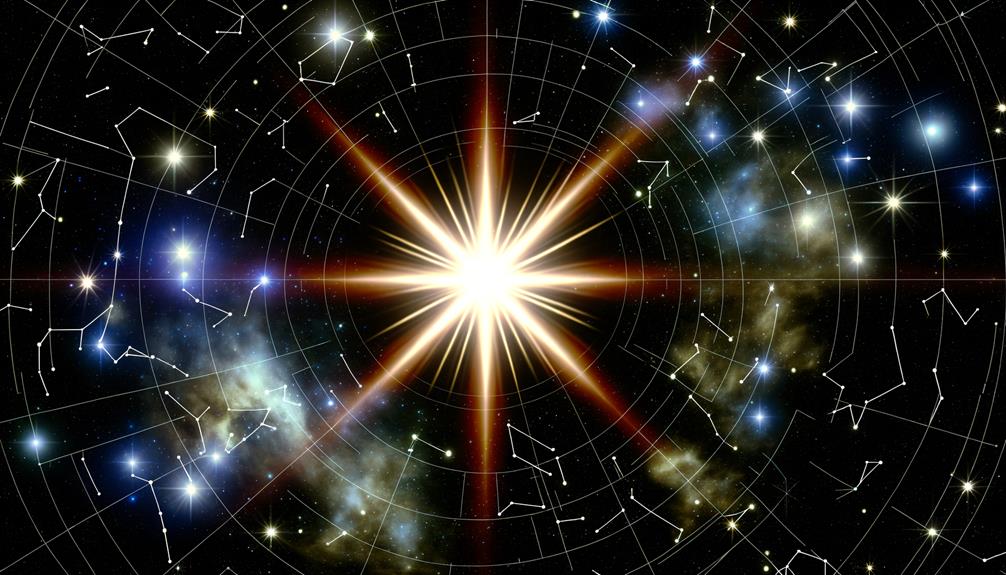
Astronomical theories regarding the Christmas Star suggest it could have been a natural celestial phenomenon, such as the conjunction of planets, a comet, or a supernova.
Scholars have analyzed historical astronomical records to ascertain which events align with the biblical timeline.
These scientific inquiries provide plausible explanations that bridge historical accounts with observable cosmic events.
Natural Celestial Phenomenon
Various astronomical theories have been proposed to explain the natural celestial phenomenon traditionally referred to as the Christmas Star. Scholars and astronomers have examined historical records and astronomical data to identify plausible natural events that could align with the biblical narrative.
Among the prominent hypotheses are supernovae, which are powerful and luminous stellar explosions, and cometary appearances, which were often considered omens or significant markers in ancient times.
These theories are evaluated based on their visibility, duration, and historical documentation around the estimated time of Jesus’ birth.
Each hypothesis provides insights into how ancient observers might have interpreted extraordinary celestial occurrences, while also attempting to correlate these events with the Gospel accounts.
Conjunction of Planets
Among the various astronomical explanations, the conjunction of planets stands out as a compelling theory for the phenomenon known as the Christmas Star.
This theory posits that the alignment of Jupiter and Saturn, occurring around 7-6 B.C., could have produced an exceptionally bright celestial event. Scholarly analyses suggest that such a conjunction would have been visible to the naked eye and could have been interpreted by ancient observers as a significant astronomical sign.
Contextually, the Magi, or Wise Men, who were skilled in astrology, might have regarded this rare alignment as heralding an extraordinary event, guiding them to Bethlehem.
This theory aligns with historical and biblical timelines, providing a plausible astronomical basis for the Christmas Star narrative. By examining celestial events that occurred around the time of Jesus’s birth, such as planetary conjunctions or supernovae, scholars have drawn parallels that support this theory. Additionally, the advent calendar biblical significance reminds us of the importance of anticipation and reflection during the lead-up to Christmas, enriching our understanding of the season. Ultimately, both astronomical and biblical perspectives contribute to a fuller appreciation of the nativity story and its profound impact on Christian tradition.
Comet or Supernova
Two alternative theories propose that the Christmas Star might have been a comet or a supernova, each offering a distinct but scientifically intriguing explanation for the biblical phenomenon.
The comet theory suggests that a notable comet, with its bright tail and prolonged visibility, could have captured the attention of the Magi. Historical records indicate that comets were often seen as omens, potentially aligning with the biblical narrative.
Conversely, the supernova hypothesis posits that an exploding star could have produced a brilliant, persistent light, visible even in daylight. Ancient Chinese and Korean records document celestial events resembling supernovae around the estimated time of Jesus’ birth.
Both theories provide compelling astronomical contexts, though neither conclusively identifies the nature of the Christmas Star.
Symbolism in Christian Tradition
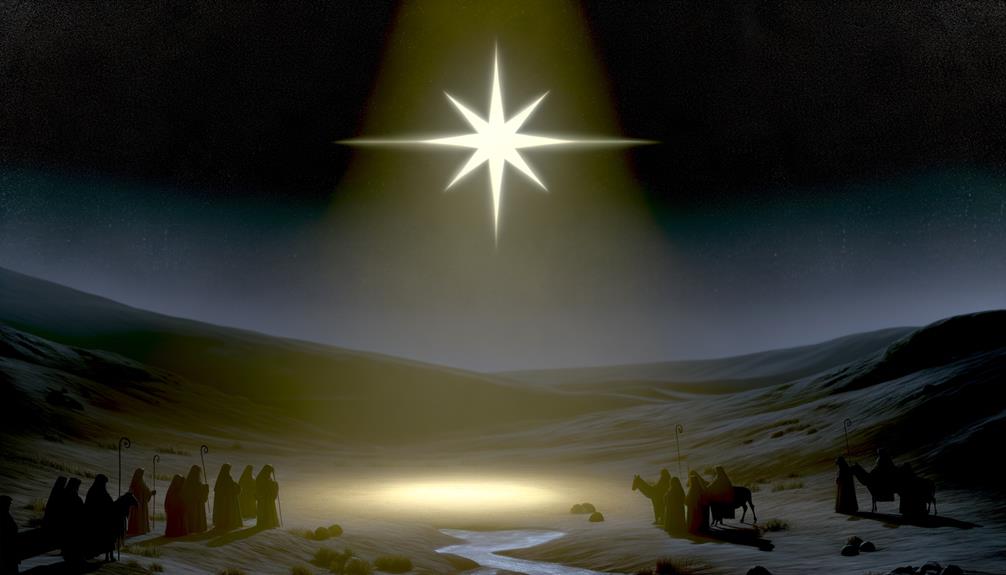
In Christian tradition, the Christmas Star is profoundly emblematic, symbolizing divine guidance and the fulfillment of biblical prophecy.
Its appearance in the nativity narrative, guiding the Magi to the birthplace of Jesus, is interpreted as a manifestation of God’s intervention in human history.
The star’s symbolism is multifaceted; it represents the light of Christ entering the world, offering spiritual illumination and hope.
Additionally, it signifies the realization of Old Covenant prophecies, such as those in Numbers 24:17 and Isaiah 60:3, which foretell a rising star linked to the Messiah.
Therefore, the Christmas Star serves as a theological anchor, reinforcing the belief in Jesus as the prophesied Savior and underscoring themes of revelation and divine orchestration within Christian doctrine.
The Star in Art and Culture
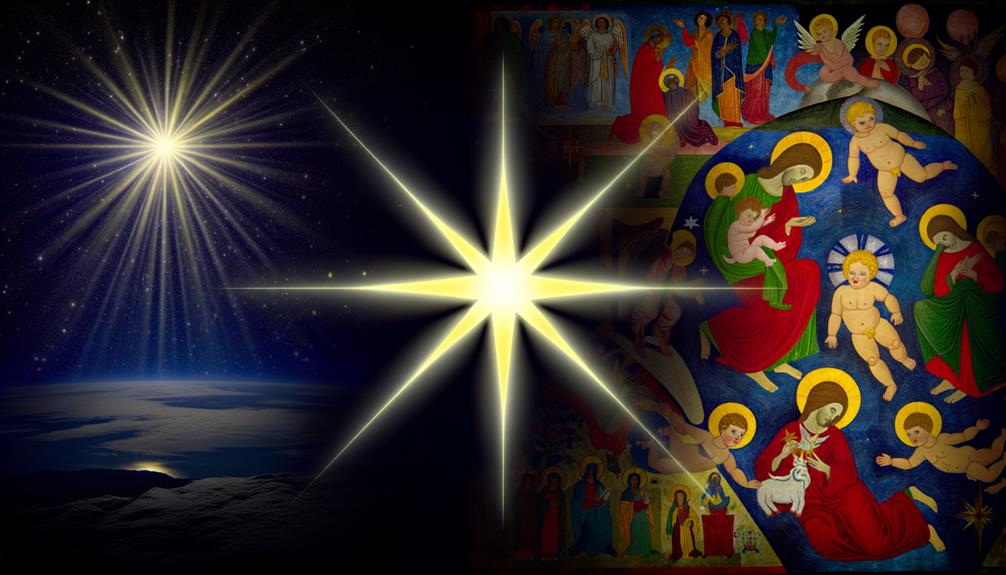
The Christmas Star has transcended its religious origins to become a prominent motif in various forms of art and cultural expression, symbolizing themes of hope, guidance, and celestial wonder.
Historically, artists have depicted the star in nativity scenes, often positioning it as a divine beacon guiding the Magi.
In literature, it frequently appears as a metaphor for enlightenment and spiritual quest.
Additionally, the motif has permeated music, where it inspires compositions that evoke the star’s luminous significance.
Cultural festivities, including Christmas pageants and decorations, employ the star to evoke a sense of wonder and anticipation.
This widespread adoption underscores the star’s potent symbolism, anchoring it firmly in both religious and secular narratives across diverse artistic mediums.
The Star’s Modern Interpretations
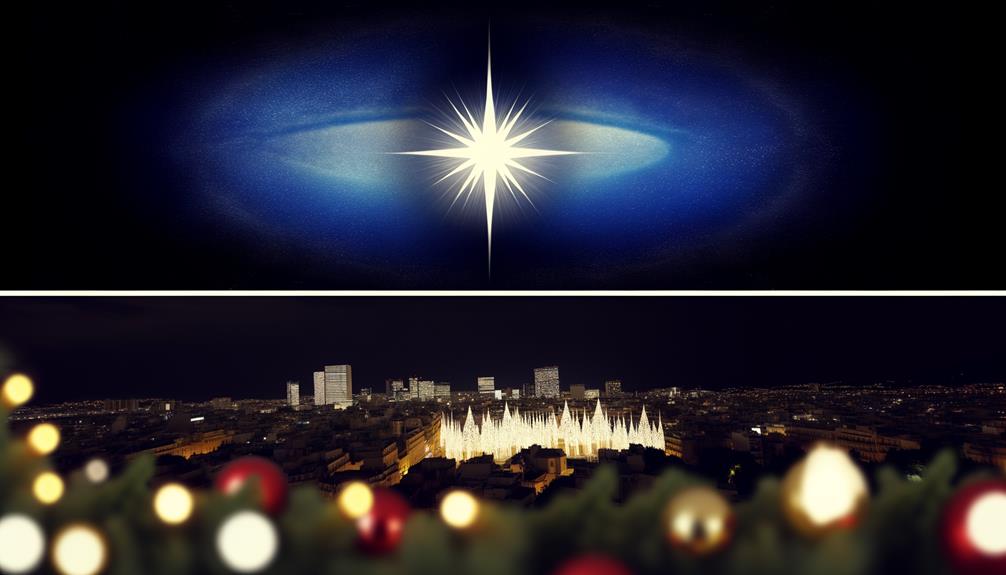
Contemporary interpretations of the Christmas Star often reflect a blend of traditional symbolism and modern secular themes, highlighting its enduring relevance in today’s cultural and social landscape. Scholars and enthusiasts alike debate its astronomical origins, while its symbolic representation as a beacon of hope and guidance remains undiminished. In secular contexts, the star has transcended its biblical roots to become a universal symbol of aspiration and enlightenment.
| Aspect | Traditional Interpretation |
|---|---|
| Astronomical Origin | Divine celestial event |
| Symbolism | Hope, guidance, divine intervention |
| Modern Secular Themes | Aspiration, enlightenment, universal hope |
| Cultural Relevance | Maintains significance across various contexts |
This fusion of meanings underscores the star’s multifaceted role in both religious and broader cultural narratives.
Conclusion
The Christmas star, as chronicled in biblical texts, embodies a celestial beacon guiding the Magi, fulfilling ancient prophecies, and symbolizing divine intervention.
Its luminous presence transcends mere astronomical phenomena, representing hope, guidance, and revelation within Christian tradition.
Through the lens of art and culture, the star continues to inspire, reflecting humanity’s quest for meaning and the eternal search for the divine.
In modern interpretations, this radiant symbol endures, illuminating the timeless intersection of faith and cosmic wonder.



